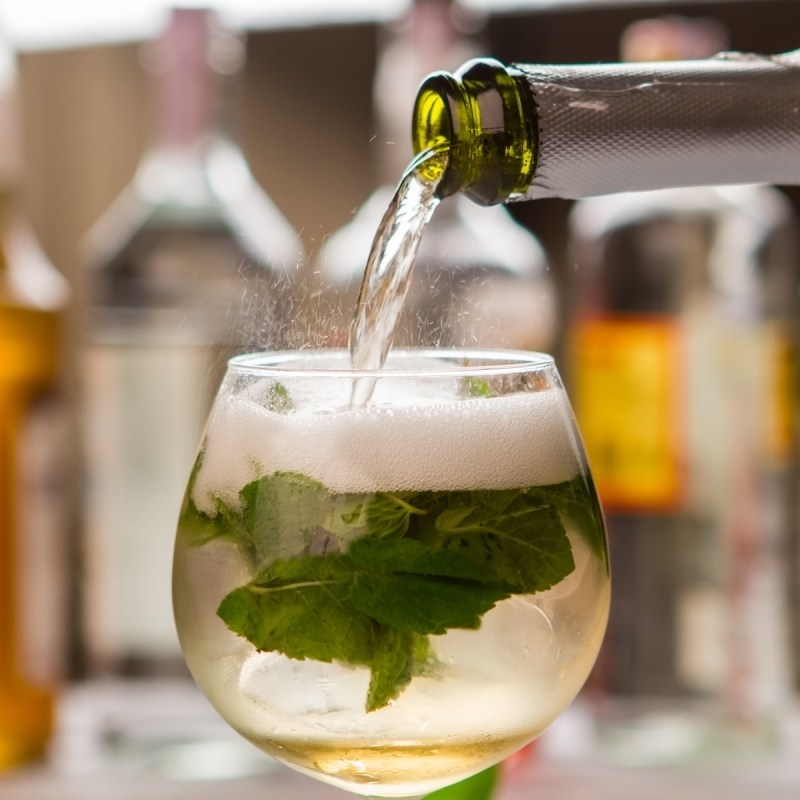
The aperitivo is practically an institution in Italy. An early evening drink, the aperitivo is supposed to stimulate the appetite before dinner, as compared to the digestivo, a drink supposed to help with digestion after dinner. While this sounds as if Italians use any old excuse to enjoy a nice drink — and why not? — the aperitivo is much more a social and lifestyle choice rather than simply a medicinal one.
Videos by TravelAwaits
Walk around Rome in the early evening, all the terraces and bars are filled with people meeting friends, catching up after work before heading home, or couples enjoying the afternoon’s golden light before sunset.
The drinks are usually accompanied by some light — and often free — snacks, ranging from olives, chips, chips, salami, or even small arancini or suppli, which often double as antipasti.
It is the time when, after a day’s sightseeing, you can sit down and relax, even in overcrowded, popular hotspots, because even the most touristy bars can’t go too far wrong when mixing a drink.
In the name of research, I drank my way through a fair few aperitivos in Rome recently, using any excuse to sit down in a bar, drink in hand, to enjoy the sunset, the people-watching, and the views. Or the simple dolce far niente, doing nothing, and loving every minute.
You will notice that many of the Italian aperitivos are of orange color, as they are usually either made with Campari or Aperol. But each is subtly different and appeals to different tastes. And you will also see beer and wine being drunk, but these are not half as much fun as the proper Italian aperitivos, or, if you want to keep it Italian: aperitivi.
Here are some great drinks I tried, not all necessarily originating in Rome, but tried and tested there.

1. Campari
Everywhere
Let’s start with the Campari, because it is not only drunk pure, on the rocks, with soda or other mixers, but it is also the base of many Italian aperitivos. Like many food items with a strong and distinctive taste, people either tend to hate it or love it. Campari is, let’s face it, very bitter. And it is, indeed classed under “bitters” in the liquor dictionary, denoting alcoholic drinks made with bitter or sour botanical matter. It is quite difficult to find out exactly what the ingredients in Campari are, apart from many bitter herbs few people have ever heard of, but it is an easily spotted drink, with its orange hue, redder than Aperol, but bright nevertheless.
Campari always reminds me of my dad, who always drank it either on ice, or with some soda water. Grabbing a taste when I was younger made me flinch and pull a face, but somehow it also seems to have paved the way to my liking Campari and Campari-infused drinks as an adult.
And, going out for an aperitivo in Italy, you will be hard-pressed to find one that is not in some way related to Campari. To get the taste but without having to pull a face, try a Campari Orange, a small measure of Campari diluted with fresh orange juice. You get the sweetness of the orange, but it is cut through with the bitterness of the Campari making the orange juice less sweet and the Campari less bitter. A win-win, really.

2. Aperol Spritz
Il Palazzetto
Probably the most popular aperitivo in Italy — and France for that matter — is the Aperol Spritz, easily recognized as the sparkling neon-orange drink served with a slice of orange and plenty of ice in a rather large glass. Aperol is an Italian bitter made with the herb gentian; cinchona, a flowering plant; and rhubarb and is mixed with prosecco and soda to make it into the spritz version, which is lighter and longer. Also sometimes referred to as the Spritz Veneziano, I have found that in Venice, the original Spritz you order can often simply be a white wine spritzer rather than an Aperol Spritz. Either way, wherever you go in Rome in the early evening, the bright orange hue calls you from afar.
For the best location to enjoy your Aperol Spritz as well as great views and the sunset, head straight to Il Palazzetto, one of my favorite rooftop terraces in Rome right at the top of the Spanish Steps.

3. The Americano
Baccano
One firm favorite of the Romans is The Americano, not to be confused with the coffee of the same name. The Americano is another spritz, also of orange hue, but made with DiBaldo 721 Vermouth, Campari, and soda. The Campari’s bitter taste is there, but diffused by the sweet vermouth taste, and made fresher and lighter with the soda. Less alcoholic than the Aperol Spritz because it does not have prosecco in it, it is a refreshingly light summer’s drink.
The travel-inspired cocktail menu at Baccano — just by the Trevi Fountain and open all day for food and drinks — features the best cocktails and aperitivos from around the globe, which makes it quite dangerous to travelers like us, because the various drinks either conjure up memories from previous trips or invite you to be inspired for future trips. But the Americano here is listed as an Italian favorite, and when in Rome… you know what to do.

4. The Hugo
The Pavilions Rome, First Musica
I tried my first Hugo on the rooftop of The Pavilions Rome, First Musica overlooking the Tiber and with Rome stretching beyond it. This is a Spritz for those yet unaccustomed to the Italian love for bitters. Made without any Campari or Aperol, it is clear and not bitter at all. Instead, The Hugo is mixed with prosecco and elderflower cordial, soda, and mint, making it refreshing and only slightly alcoholic and very cooling on a summer’s evening.
That said, some recipes add a dash of gin, while others add lime; I guess everybody tried to enhance the old recipe somehow. It originates along the northern border of Italy, from South Tyrol, with influences from Austria, Switzerland, and/or Germany, hence the lack of Campari and the Germanic name. If you want to ease yourself into the various Italian aperitivos, then this is a great start.

5. Negroni
Piazza Navona
And here is another orange-hued contender. It is my husband’s favorite but tends to be a little too strong for me. Made with, of course, Campari, sweet vermouth, and gin with a slice of orange and some ice, it is, unlike most of the other drinks mentioned here, entirely made of liquor and therefore quite potent. If diluted with a splash of soda water, as often requested by traveling Americans in and around Milan where it originates, it turns into The Americano (see above), no longer being a proper Negroni.
That said, you can now also get Negroni Spritzes, locally called Negroni Sbagliato, and it uses all the same ingredients — sometimes minus the gin — as a normal Negroni, but is “diluted” with prosecco. So, again, rather potent. It tastes lighter, but in this case, the snacks that tend to accompany an aperitivo in Italy are not only welcome but also necessary for you to be able to walk in a straight line after indulging.
Have a Negroni Spritz on one of Piazza Navona’s many terraces — such as the Il Grifone — because I have a feeling they diluted the Negroni somewhat, making it more drinkable and less strong. Some would call it sacrilege; I think it is rather useful.

6. Sparkling Wines
Hassler Bistro At Palm Court
There is no beating prosecco, not when it comes to fame around the world, nor when it comes to sales around the world. Italy is the leading producer of sparkling wine, and prosecco is the country’s most famous sparkling export. And who doesn’t like prosecco? Actually, I must sheepishly admit that I do not like it. I don’t know what it is, maybe the process, which differs slightly from other sparkling creations such as champagne. I really don’t know, but I tend to avoid it.
Instead, I found a wonderful sparkling Italian wine at the Hassler Bistro at Palm Court, which the sommelier suggested after I fessed up to not liking his country’s most famous sparkling wine. It was a Monte Rossa Coupé, and I really enjoyed it. And no, this is not an advert. Like prosecco, it comes from northern Italy, but I found it lighter, with smaller bubbles, and perfect as a pre-food drink.
Pro Tip: The sparkling wine is best enjoyed outside in the Palm Court’s lovely setting, but head inside at the Salone Eva, where the sumptuous armchairs and the odd tortoise harking back to the former owner’s love for the gentle reptiles is perfect for a stronger Negroni, which is very much suited to cooler months.
Want to recreate your favorite aperitivo back home? Take a mixology class in Rome.
